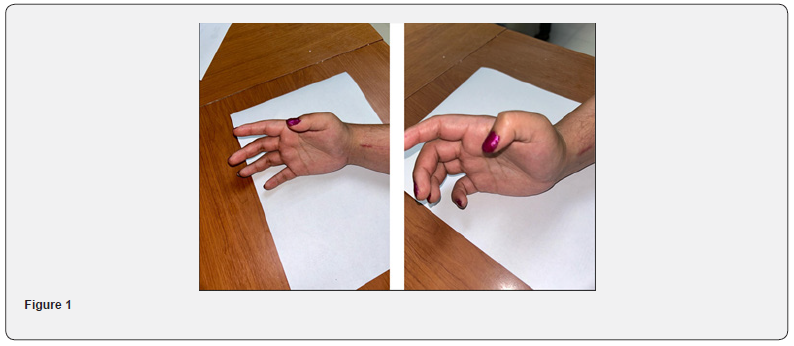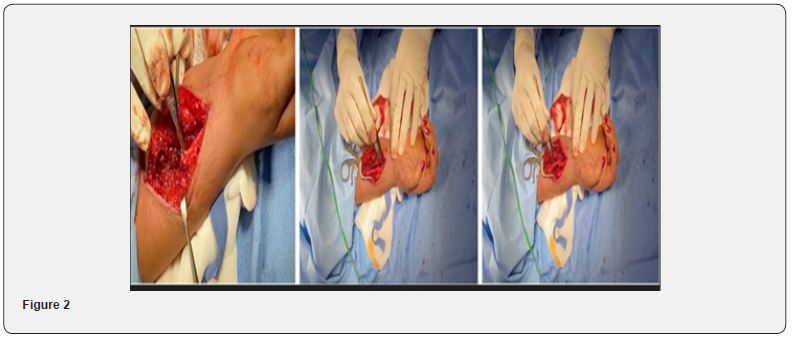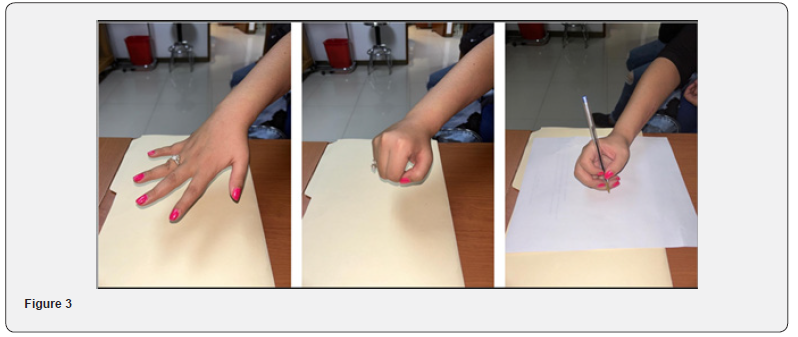Flexor Pollicis Longus Tendon Rupture After Volar Radius Plating: Reconstruction with Brachioradialis (BR) Tendon Transfer
Ricardo Monreal Gonzalez*
Medica Vial Orthopedic Clinic, Alvaro Obregon, Roma Norte, Mexico City
Submission: May 01, 2024; Published: June 07, 2024
*Corresponding author: Ricardo Monreal Gonzale, Medica Vial Orthopedic Clinic, Alvaro Obregon, Roma Norte, Mexico City, Email: rmonreal59@yahoo.es
How to cite this article: Ricardo Monreal Gonzalez z. Flexor Pollicis Longus Tendon Rupture After Volar Radius Plating: Reconstruction with Brachioradialis (BR) Tendon Transfer. Ortho & Rheum Open Access J. 2024; 23(3): 556111. DOI: 10.19080/OROAJ.2024.23.556111
Abstract
Flexor pollicis longus (FPL) tendon rupture is a severe complication after volar plating of the radius fractures. FPL reconstruction with brachioradialis (BR) tendon transfer is a valuable treatment option that can provide good functional recovery of hand function. The purpose of this study was to present a case of rupture and adhesion of the flexor pollicis longus tendon treated by reconstruction with brachioradialis (BR) tendon transfer.
Keywords: Volar Radius Plating; Brachioradialis; tip-to-tip pinch; IP joint flexion; Surgical treatment
Abbreviations: FPL: Flexor pollicis longus; BR: Brachioradialis; FDS: Flexor Digitorum Superficialis; IP: Inter Phalangeal
Introduction
Spontaneous ruptures of the flexor pollicis longus (FPL) tendon are rare. In the past it was typically described in patients with rheumatoid arthritis (Mannerfelt lesion) [1] and when a scaphoid osteophyte erodes through the volar wrist capsule it can cause an attritional rupture of the FPL-tendon [2]. The introduction of angular stable volar plating to treat distal radius fractures in 2000 [3] has been associated with an increasing incidence of FPL-tendon ruptures [4-6]. The main contributing factor is flexor tendon wear over the distal edge of a plate if this is placed superficial or distal to the watershed line [7].
Although brachioradialis tendon transfer is thought to offer limited tendon excursion and finger motion, it was used to restore active thumb and digital function. The brachioradialis was transferred to the flexor pollicis longus (FPL), to the flexor digitorum profound or to the common digital extensors [8]. Primary repair of chronic FPL tendon ruptures is difficult due to tendon abrasion and retraction. Treatment options are interposition tendon graft, tendon transfer of the 3rd or 4th flexor digitorum superficialis (FDS) to the thumb [9], tendon advancement or IP joint fusion [10]. Preferred management for chronic FPL tendon ruptures has not been determined yet as only a few reports present the outcome of their surgical treatment in detail [11].
The purpose of this study was to present a case of rupture and adhesion of the flexor pollicis longus tendon treated by reconstruction with brachioradialis (BR) tendon transfer.
Case Presentation
After an open reduction and osteosynthesis of the radius and ulna was performed, an adhesion of the flexor pollicis longus tendon developed, producing passive flexion of the thumb when actively extending the wrist due to a tenodesis effect (Figure 1). After confirming the consolidation of the radius fracture, the plate was removed, finding that the tendon of the flexor pollicis longus was ruptured and included in the bone callus, which was released, and it was decided to transfer the tendon of the supinator longus (brachioradialis) towards the flexor pollicis longus tendon (Figure 2). Although interphalangeal (IP) flexion of the thumb did not return to normal after surgery, the patient reported excellent functional result (Figure 3). The primary function of the FPL tendon is to position and to stabilize the thumb for tip-to-tip pinch and fingernail pickup [12]. This function requires 20° to 30° of IP joint flexion and can be expected after PL tendon interposition.



FPL tendon rupture is a severe complication after volar plating of the radius fractures. Preferred treatment of FPL rupture in this indication has not been determined yet and not much is known about outcome of eventual surgical treatment. FPL reconstruction with brachioradialis (BR) tendon transfer is a valuable treatment option that can provide good functional recovery of hand function.
Conclusion
TG is a rare but not exceptional benign tumor that is often misunderstood. The diagnosis is mainly clinical and the treatment is exclusively surgical, the histopathological examination confirms the diagnosis.
Recurrence is exceptional if the excision is complete.
Acknowledgement
The authors declare no conflict of interest in connection with the writing of this article.
References
- Mannerfelt L, Norman O (1969) Attrition ruptures of flexor tendons in rheumatoid arthritis caused by bony spurs in the carpal tunnel. A clinical and radiological study. J Bone Joint Surg Br 51(2): 270-277.
- Breedveld FC (2002) Current and future management approaches for rheumatoid arthritis. Arthritis Res 4(Suppl 2): 16-21.
- Orbay JL (2000) The treatment of unstable distal radius fractures with volar fixation. Hand Surg 5(2): 103-112.
- Bell JSP, Wollstein R, Citron ND (1998) Rupture of flexor pollicis longus tendon. A complication of volar plating of the distal radius. J Bone Joint Surg 80(2): 225-226.
- Johnson NA, Cutler L, Dias JJ, Ullah AS, Wildin CJ, Bhowal B (2014) Complications after volar locking plate fixation of distal radius fractures. Injury 45(3): 528-533.
- Klug RA, Press CM, Gonzalez MH (2007) Rupture of the flexor pollicis longus tendon after volar fixed-angle plating of a distal radius fracture: a case report. J Hand Surg 32(7): 984-988.
- Soong M, Earp BE, Bishop G, Leung A, Blazar P (2011) Volar locking plate implant prominence and flexor tendon rupture. J Bone Joint Surg Am 93(4): 328-335.
- Failla JM, Peimer CA, Sherwin FS (1990) Brachioradialis Transfer for Digital Palsy. J Hand Surgery 15(3): 312-316.
- Schmitt S, Mühldorfer-Fodor M, van Schoonhoven J, Prommersberger KJ (2013) Restoration of thumb flexion at the interphalangeal joint by transposition of the flexor digitorum superficialis tendon from the ring finger. Open Orthop Traumatol 25(4): 321-330.
- Schneider LH, Wiltshire D (1983) Restoration of flexor pollicis longus function by flexor digitorum superficialis transfer. J Hand Surg Am 8(1): 98-101.
- Pieter Berger, Joris Duerinckx (2017) Flexor pollicis longus tendon rupture after volar wrist plating: reconstruction with palmaris longus interposition graft. Acta Orthop Belg 83(3): 467-472.
- Kilgore ES, Newmeyer WL, Graham WP, Brown LG (1976) The dubiousness of grafting the flexor pollicis longus. Am J Surg 132(2): 292-296.






























